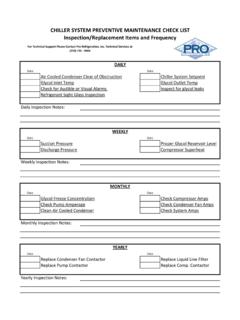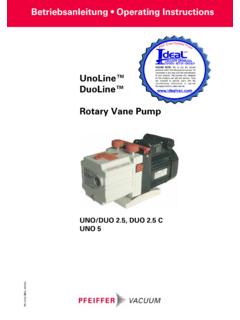Transcription of WINERY GLYCOL CHILLER SYSTEM DO IT YOURSELF TIPS
1 WINERY GLYCOL CHILLER SYSTEM DO IT YOURSELF TIPS By Jim VanderGiessen Jr, Pro Refrigeration Inc. I am often asked by WINERY customers what kinds of things they can do themselves to maintain their GLYCOL CHILLER systems. The following list of items can hopefully help improve some operating efficiencies, help identify issues before they become serious, and help familiarize you with your GLYCOL CHILLER SYSTEM . 1) PROPER GLYCOL CONCENTRATION AND TANK LEVEL Propylene GLYCOL is in very simple terms a Food Grade Antifreeze. To achieve operating temperatures below 45 F, you will need to add propylene GLYCOL to prevent SYSTEM freeze up. The standard rule is to maintain a Freeze Point 20 to 25 F below your thermostat set point. For example, if your thermostat is set at 25 F, your freeze point should be 5 F or below the lowest ambient temperatures.
2 The shaded area in the chart below reflects the recommended range for CHILLER systems operating in the +25 F temperature range. Weight % Propylene GLYCOL Volume % Propylene GLYCOL Freezing Point in Fahrenheit FreezingPoint inCelsius DegreeBrix** 0 0 32 0 20 25 19 30 22 31 32 33 34 35 36 37 38 28 39 40 -6 45 50 shaded area represents recommended GLYCOL Water
3 Percentage * GLYCOL freeze point should be 20 to 25 F. below operating temperature or below coldest winter ambient conditions. Whichever is coldest. ** Degree Brix is a measure of sugar concentration in a fluid and is important in fermentation applications. Although there are no sugars in GLYCOL , it will affect the refractive index of the fluid in a similar fashion. The most simple way to check your GLYCOL concentration is by using a Refractometer. The Refractometer will provide the freeze point in degrees or in brix. Another way to check the GLYCOL concentration is by utilizing a hydrometer to determine the specific gravity. 30% Volume = SG = freeze point F 35% Volume = SG = freeze point F 40% Volume = SG = freeze point -6 F Misco brand Refractometer Having too much or too strong of a GLYCOL concentration can also have a negative effect on your CHILLER SYSTEM by reducing the heat exchange properties.
4 This will force your SYSTEM to operate at lower evaporator temperatures and reduce your overall SYSTEM capacity. The GLYCOL Tank Level is also critical to proper operation. Many GLYCOL tanks will have external Sightglasses installed or GLYCOL tank level alarms to help monitor this and alert you of GLYCOL leaks in your SYSTEM . 2) REFRIGERANT PRESSURES AND GLYCOL TEMPERATURE The GLYCOL temperature is generally the only data people take notice of on a CHILLER SYSTEM . Usually, there are a number of other gauges and instruments that can provide valuable data, even if you have no understanding of refrigeration. We recommend a log be maintained where all of the available operating data is recorded. By recording this data on a regular basis you can be alerted to possible issues before they become critical. Refrigerant Pressure Gauges should be installed on each compressor on your CHILLER SYSTEM .
5 If your CHILLER SYSTEM was not supplied with these gauges, request they be added by your refrigeration service mechanic. Before logging the refrigerant pressures, also note the GLYCOL temperature and ambient temperature (on air cooled systems). These pressures will fluctuate based on the GLYCOL temperature and changing ambient conditions. 3) LIQUID LINE SIGHTGLASS Most WINERY CHILLER systems have a Liquid Line Sightglass located somewhere on the Liquid Refrigerant Line that feeds refrigerant to the GLYCOL /Refrigerant Heat Exchanger. With the compressor running, you should have a clear Sightglass with no bubbles. It is normal to see bubbles during start up, but these should quickly clear up after 60 seconds. If bubbles are present after start up, this can indicate a low refrigerant charge or even possibly a freeze up condition.
6 Liquid Line Sightglass 4) AIR COOLED CONDENSER Most CHILLER systems utilize Air Cooled Condensers to reject the heat to the atmosphere. When this condenser gets dirty or obstructed, it can significantly effect the operating pressure of the SYSTEM and greatly reduce the operating efficiency. This can also cause High Head Pressure Alarms that will shut the SYSTEM down. Care must be taken if you attempt to clean these coils YOURSELF . Be very cautious to not bend or damage the fins, this could cause more harm than a fouled condenser. These coils can be cleaned using compressed air. For severe applications, specially designed intake screens can be installed to minimize and simplify the cleaning process. Severely fouled air cooled condenser (Provided by Air Solution Company) These are just a few easy items to check and monitor on not only the CHILLER SYSTEM but any refrigeration SYSTEM on the WINERY .
7 For additional articles, troubleshooting guides, GLYCOL percentage charts, and much more please visit our website at Jim VanderGiessen Jr. is CEO and general manager of Pro Refrigeration Inc., Auburn, WA., a 17 Year Company specializing in manufacturing GLYCOL CHILLER SYSTEM for numerous Food and Beverage Markets.







